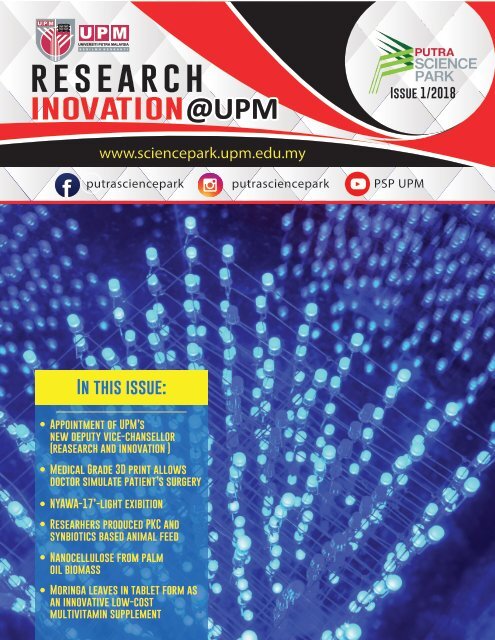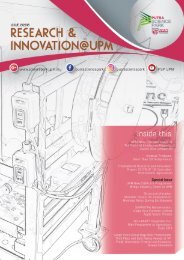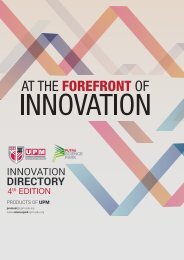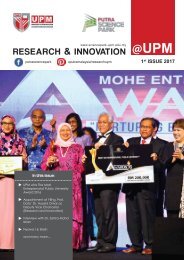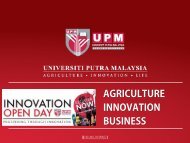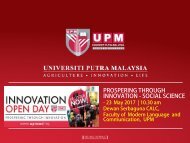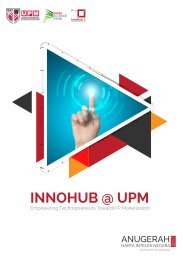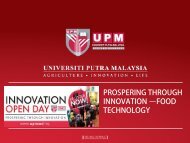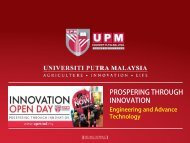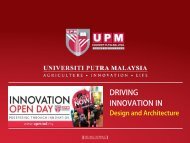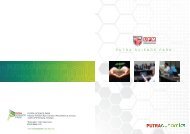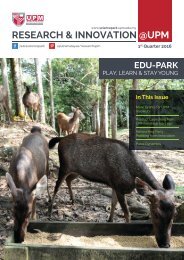PSP BULLETIN 1-2018
more info at Putra Science Park, Universiti Putra Malaysia , Serdang Selangor Malaysia www.sciencepark.upm.edu.my
more info at Putra Science Park, Universiti Putra Malaysia , Serdang Selangor Malaysia www.sciencepark.upm.edu.my
You also want an ePaper? Increase the reach of your titles
YUMPU automatically turns print PDFs into web optimized ePapers that Google loves.
RESEARCH & INNOVATION @ UPM I 1st ISSUE <strong>2018</strong><br />
1<br />
R E S E A R C H<br />
INOVATION<br />
@UPM<br />
Issue 1/<strong>2018</strong><br />
www.sciencepark.upm.edu.my<br />
putrasciencepark putrasciencepark <strong>PSP</strong> UPM<br />
In this issue:<br />
Appointment of UPM’s<br />
new deputy vice-chansellor<br />
(reasearch and innovation )<br />
Medical Grade 3D print allows<br />
doctor simulate patient’s surgery<br />
NYAWA-17’-light exibition<br />
Researhers produced PKC and<br />
synbiotics based animal feed<br />
Nanocellulose from palm<br />
oil biomass<br />
Moringa leaves in tablet form as<br />
an innovative low-cost<br />
multivitamin supplement
2 RESEARCH & INNOVATION @ UPM I 1st ISSUE <strong>2018</strong><br />
Editorial Team<br />
Advisor<br />
Prof. Dr. Samsilah Roslan<br />
Chief Editor<br />
Dr. Mohamad Fakri Zaky<br />
Jaafar<br />
EDITORS<br />
Hafliza Hussin<br />
Asrizam Esam<br />
Shazlan Halamy<br />
Coordinator<br />
Shazlan Halamy<br />
Graphic Designers<br />
Mohd Mas’Ataillah<br />
Ismail<br />
Photographer<br />
Saleha Haron<br />
Circulation<br />
Mohd Hisham Omar<br />
Voice of Chief Editor<br />
It is with a great pleasure I am writing as<br />
the editor for the first issue of Research<br />
and Innovation @ UPM for <strong>2018</strong>. This<br />
publication is meant to share Putra Science<br />
Park’s (<strong>PSP</strong>) activities and achievements<br />
for the university.<br />
First and foremost, <strong>PSP</strong> would like to extend<br />
its heartfelt congratulations to YBhg. Prof.<br />
Dr. Zulkifli Idrus upon his appointment as<br />
the new Deputy Vice-Chancellor (Research<br />
and Innovation), replacing YBhg. Prof. Dato’<br />
Dr. Husaini Omar who was appointed Vice-<br />
Chancellor of Universiti Malaysia Kelantan,<br />
to whom our heartiest thanks is due.<br />
Our stories in this issue shed some light on<br />
several achievements and activities that we<br />
have conducted through the year.<br />
Since Malaysia is perceived as the global<br />
market leader in halal industry due to its<br />
ecosystem and proactive policies, UPM<br />
has also taken the liberty to introduce into<br />
the market its pure and clean animal feed<br />
known as ‘Thohira’, a brainchild of Prof. Dr.<br />
Shuhaimi Mustafa, Director of UPM Halal<br />
Research Institute.<br />
This edition also highlights other innovations<br />
consisting of medical apparatus known as<br />
Medical Grade Print or ‘MeG3rd’ that helps<br />
surgeons in pre-treatment planning prior to<br />
performing complex surgery procedures,<br />
led by Prof. Dr. Ahmad Sobri Muda and the<br />
development of Nanocellulose from palm oil<br />
biomass, an innovation by Assoc. Prof. Dr.<br />
Hidayah Ariffin and her team.<br />
Another exciting innovative product is the<br />
development of Moringa oleifera leaves as<br />
a low-cost multivitamin supplement in tablet<br />
form, which can potentially be served as a<br />
food supplement for everyone, especially for<br />
the B40 group known as ‘Chewable Moringa<br />
Fruity Tablets’, invented by Assoc. Prof. Ir. Dr.<br />
Yus Aniza Yusof and her team from Faculty of<br />
Engineering.<br />
NYAWA exhibition has reached its sixth<br />
edition with the launch of NYAWA’17:<br />
LIGHT, showcasing 21 artefacts with the<br />
use of interactive technology. The event was<br />
officiated by the UPM’s Chairman of the Board,<br />
Prof. Emeritus Tan Sri Dr. Anuwar Ali. Each<br />
artefact was presented in artistically such as<br />
in the form of digital and graphic arts that was<br />
aimed to expand the community’s perspective<br />
through the fusion between science and arts.<br />
I hope you enjoy reading the Research &<br />
Innovation @ UPM. I look forward to keeping<br />
you informed.<br />
Dr. Mohamad Fakry Zaky Jaafar<br />
Deputy Director<br />
Innovation Promotion and Marketing Division<br />
Putra Science Park
RESEARCH & INNOVATION @ UPM I 1st ISSUE <strong>2018</strong><br />
3<br />
Appointment OF UPM’s<br />
NEW DEPUTY VICE-CHANCELLOR<br />
(RESEARCH AND INNOVATION)<br />
PUTRAJAYA - The Ministry of<br />
Higher Education announced the<br />
appointment of Professor Dr. Zulkifli<br />
Idrus as UPM’s new Deputy Vice-<br />
Chancellor (Research and Innovation),<br />
for three consecutive years starting<br />
from April 15, <strong>2018</strong> to April 14, 2021.<br />
His letter of appointment was signed by<br />
the Minister of Higher Education, Dato’<br />
Seri Idris Jusoh on April 4, <strong>2018</strong>. Prof.<br />
Dr. ZulkifliIdrus replaced the former<br />
Deputy Vice-Chancellor, Prof. Dato’Dr.<br />
Husaini Omar, who was appointed<br />
as the Vice-Chancellor of Universiti<br />
Malaysia Kelantan (UMK) on 1 January<br />
<strong>2018</strong>.<br />
Prof. Zulkifli was a professor at the<br />
Department of Animal Science, Faculty<br />
of Agriculture, Universiti Putra Malaysia<br />
(UPM). He completed his degree in<br />
Veterinary Medicine in 1984 and later<br />
pursued a Master’s degree in Poultry<br />
Science at the same university in 1990.<br />
He was born on April 7, 1965 and<br />
was educated at La Salle Secondary<br />
School in Petaling Jaya. He<br />
subsequently obtained a PhD from<br />
Virginia Polytechnic Institute and State<br />
University, USA in 1994,also inthe field<br />
of Poultry Science. Zulkifli started his<br />
career as a Lecturer at the Department<br />
of Animal Science, UPM in 1994 and<br />
was promoted to Associate Professor<br />
in 1999 and Professor in 2004.<br />
Prof. Zulkifli has devoted his<br />
professional career to achieve<br />
excellence in both teaching and<br />
research in the field of Poultry Science<br />
and Animal Welfare. He has received<br />
numerous public, international and<br />
industry research grants totaling more<br />
than RM15 million.<br />
Between 2012 and 2017, he led the<br />
Long Term Research Grant Scheme<br />
(LRGS) programme that filled a niche<br />
in the field of food security titled<br />
‘Enhancing the Competitiveness and<br />
Sustainability of the Poultry Industry<br />
through Improved Feedstock’ worth<br />
RM11.68 million which was funded by<br />
the Ministry of Higher Education.<br />
During his tenure in UPM, Prof. Zulkifli<br />
was appointed as the Deputy Director<br />
(2003 - 2005) and Director (2004 -<br />
2010) of the Research Management<br />
Centre and the Director (since 2010)<br />
of the Institute of Tropical Agriculture<br />
and Food Security (ITAFoS). During<br />
his term, ITAFoS was awarded the<br />
‘Higher Institution Centre of Excellence’<br />
(HICoE) by the Ministry of Higher<br />
Education Malaysia on January 1, 2017<br />
for filling a niche in the field of ‘Tropical<br />
Agrifood’. Zulkifli is also the former<br />
President of the World Poultry Science<br />
Association (Malaysian branch) from<br />
2012 to 2017. - UPM<br />
“<br />
Prof. Zulkifli<br />
has devoted his<br />
professional<br />
career to achieve<br />
excellence in<br />
both teaching<br />
and research<br />
in the field of<br />
Poultry Science<br />
and Animal<br />
Welfare.<br />
“<br />
Professor Dr. Zulkifli Idrus<br />
Deputy Vice-Chancellor<br />
(Research and Innovation)
4 RESEARCH & INNOVATION @ UPM I 1st ISSUE <strong>2018</strong><br />
Researchers produce PKC and<br />
synbiotics based animal feed<br />
Humans<br />
completely<br />
replace their outer<br />
skin every month<br />
Humans completely<br />
replace their outer<br />
skin every month<br />
The average<br />
chocolate bar<br />
contains eight<br />
insect pieces<br />
Mosquitoes have<br />
killed more<br />
humans than all<br />
wars in history<br />
There are more<br />
stars in the sky<br />
than grains of<br />
sand in the world<br />
SERDANG - Universiti Putra Malaysia’s<br />
(UPM) research team has successfully<br />
produced animal feed from palm kernel<br />
(PKC) and synbiotics. These particular feed<br />
is rich in various enzymes, proteins and<br />
metabolites that increase the nutritional and<br />
prebiotic content of the feed.<br />
The product termed as ‘Thohira Symbiotic’,<br />
encourages the growth of livestock and is<br />
comparable to similar commercial products<br />
but at a more economical cost.<br />
Hence, breeders will be able to increase their<br />
profit. PKC refers to palm oil industry’s waste<br />
produce that has low nutrients and is not<br />
suitable for consumption by fish and poultry;<br />
however, with the usage of ‘Thohira Symbiotic’<br />
technology PKC’s nutritional content is<br />
improved, allowing it to be used in animal<br />
feed formula at a higher concentration (25-<br />
35%) without affecting the animals’ growth.<br />
The head of the research team, Prof. Dr.<br />
Shuhaimi Mustafa said that ‘Thohira<br />
Symbiotic’ is pure, clean and suitable to be<br />
used by Muslim animal breeders.<br />
Prof. Dr. Shuhaimi, who is also the Deputy<br />
Dean (Research and Graduate Studies),<br />
The product termed as<br />
‘Thohira Symbiotic’,<br />
encourages the<br />
growth of livestock<br />
and is comparable to<br />
similar commercial<br />
products but at a more<br />
economical cost.
RESEARCH & INNOVATION @ UPM I 1st ISSUE <strong>2018</strong><br />
5<br />
There are more<br />
stars in the<br />
sky than grains<br />
of sand in the<br />
world<br />
of the Faculty of Biotechnology and<br />
Biomolecular Sciences, UPM, said the<br />
animal feed formula that contains Thohira’s<br />
technology boosts nutrient and prebiotic<br />
content (Mannan-Oligosaccharides) that<br />
improves feed’s quality and stimulates the<br />
growth of microorganisms in the animals’<br />
digestive system.<br />
He said that the technology, which license<br />
was awarded to Halways Sdn Bhd, has<br />
already been in the market through<br />
aquaculture industry products since March<br />
2017, while for the poultry industry, the<br />
companies involved are testing it at breeding<br />
farms at a commercial scale.<br />
He said the research, which began in January<br />
2015 and ended in March 2017, was also<br />
mobilized by Prof. Madya Dr. Yunus Abd<br />
Shukor, Halways Sdn Bhd’s Chief Executive<br />
Officer, Muhamad Akhmal Hakim Roslan<br />
and Muhamad Amin Jahari. Halways<br />
Sdn Bhd also collaborates with NAFAS<br />
Freedmills Sdn Bhd, a National Farmers’<br />
Organization subsidiary (NAFAS), in<br />
applying Thohira’s technology to produce<br />
high-performance animal feed products<br />
according to the needs and requirements<br />
of large-scale industries. – UPM<br />
the animal feed<br />
formula that<br />
contains Thohira’s<br />
technology boosts<br />
nutrient and prebiotic<br />
content (Mannan-<br />
Oligosaccharides)<br />
that improves<br />
feed’s quality<br />
and stimulates<br />
the growth of<br />
microorganisms in<br />
the animals’ digestive<br />
system.<br />
The average<br />
chocolate bar<br />
contains eight<br />
insect pieces<br />
A strawberry<br />
is not<br />
a berry, but<br />
a banana is<br />
For every human on<br />
earth, there is 1.6<br />
million ants<br />
France was still<br />
executing people by<br />
guillotine up until<br />
1977<br />
The word ‘set’ has<br />
the most number<br />
of definitions<br />
(464) in the<br />
English language
6 RESEARCH & INNOVATION @ UPM I 1st ISSUE <strong>2018</strong><br />
Artistic artifacts showcased at<br />
NYAWA’17: LIGHT Exhibition<br />
SERDANG – A total of 21 artifacts<br />
with the theme ‘Light’,<br />
developed through scientific<br />
research by Universiti Putra<br />
Malaysia’s (UPM) researchers and<br />
presented with the use of interactive<br />
technology, are now being showcased<br />
at Galeri Serdang, Faculty of Design<br />
and Architecture, UPM.<br />
The artifacts are displayed at<br />
the indexed exhibition, ‘Nature ‘s<br />
Yield and Wonders of Art 2017’<br />
(Nyawa’17:LIGHT) from 8 November,<br />
2017 until 30 April, <strong>2018</strong> organised by<br />
the Edu-Park Division, Putra Science<br />
Park, UPM.<br />
Each artifact is presented in artistically<br />
such as in the form of digital and<br />
graphic arts. This exhibition would<br />
further expand the community’s<br />
perspective on science and art as both<br />
can be combined to form a wasilah<br />
(relationship) in the acculturation of<br />
research and innovation.<br />
The Chairman of UPM’s Board<br />
of Directors, Prof. Emeritus Tan<br />
Sri Dr. Anuwar Ali when<br />
officiating the exhibition said that<br />
an indexed publication containing<br />
articles and photos<br />
documented throughout the exhibition<br />
will be published in conjunction with<br />
the exhibition.<br />
He said it can be accessed through<br />
the Virtual Library Museum Pages<br />
(VLMP), which is part of the<br />
International Council of Museums<br />
(ICOM) which is based in Paris,<br />
France.<br />
Also present at the event was<br />
Putra Science Park Director, Assoc.<br />
Prof. Dr. Samsilah Roslan.<br />
NYAWA’17: LIGHT exhibition is open<br />
from 9 am to 4 pm (Monday-Friday). It<br />
is also open at night and on weekends<br />
with early bookings. To date, over<br />
1,000 visitors have visited NYAWA’17:<br />
LIGHT since it was opened on 8<br />
November.<br />
“<br />
He said it can be<br />
accessed through<br />
the Virtual<br />
Library Museum<br />
Pages (VLMP),<br />
which is part of<br />
the International<br />
Council of<br />
Museums<br />
(ICOM) which<br />
is based in Paris,<br />
France.<br />
“
RESEARCH & INNOVATION @ UPM I 1st ISSUE <strong>2018</strong><br />
7<br />
NYAWA’17: LIGHT exhibition is the sixth edition of the<br />
exhibition which began with<br />
NYAWA’12: FRUIT, NYAWA’13: INSECT, NYAWA’14:<br />
MICROBE, NYAWA’15: BIRD, and NYAWA’16: BRAIN. – UPM
8 RESEARCH & INNOVATION @ UPM I 1st ISSUE <strong>2018</strong><br />
Putra Science Park<br />
Some Of Our Visitors & Technology Transfer Activities<br />
R<br />
Visit from MIDA to InnoHub .<br />
Visit from the<br />
Ambassador of Turkey to<br />
Malaysia, Her Exellency<br />
Dr. Merve Kavakcı and<br />
delegates to <strong>PSP</strong>. Also<br />
present during the visit<br />
was Prof. Datin Paduka<br />
Dato’ Dr. Aini Ideris, Vice-<br />
Chancellor of Universiti<br />
Putra Malaysia.
RESEARCH & INNOVATION @ UPM I 1st ISSUE <strong>2018</strong><br />
9<br />
Value Creation and Innovation Seminar.<br />
Intellectual Property Awareness &<br />
Commercialisation Workshop.<br />
UPMIP System 2.0 Improvement Workshop.
10 RESEARCH & INNOVATION @ UPM I 1st ISSUE <strong>2018</strong><br />
MEDICAL GRADE 3D PRINT ALLOWS<br />
DOCTORS SIMULATE PATIENT’S SURGERY<br />
SERDANG - A group of researchers from Universiti Putra<br />
Malaysia (UPM) has succeeded in developing an innovative 3D<br />
Medical Grade Print (MeG3rD) or ‘Method’ that is able to replicate<br />
a 3D anatomic printing of patients’ actual defect organ (pathology)<br />
at a 1:1 ratio.<br />
The texture quality is also realistic and reflects the uniqueness or<br />
condition of each case thus, enabling doctors to carry out a medical<br />
procedure simulation using a 3D medical grade printing for pretreatment<br />
planning on complex cases before carrying out the actual<br />
procedure on patients.<br />
Hence, it helps doctors to gain a more realistic experience on medical<br />
procedure as if they were conducting it on real patients. The head of<br />
the research group, Prof. Dr. Ahmad Sobri Muda, from the Imaging<br />
Department, Faculty of Medicine and Health Sciences, said that<br />
MeG3rD is a customised anatomical model for medical treatment<br />
strategies that combine patients’ actual data and medical<br />
grade raw materials for 3D Printing.<br />
He said it was not only capable of replicating a complex<br />
pathology (defect organs) but also developing a texture that<br />
was almost identical to simulate a more realistic anatomical<br />
structure. He said it was because the raw materials used were<br />
tailored to the needs of the doctors, and the 3D printing<br />
replicates the complexity of the defect organ (pathology) with<br />
a 1:1 ratio. “These factors can increase confidence in<br />
“The texture quality is also realistic and<br />
reflects the uniqueness or condition of each<br />
case thus, enabling doctors to carry out<br />
a medical procedure simulation using a 3D<br />
medical grade printing for pre-treatment<br />
planning on complex cases before carrying<br />
out the actual procedure on patients.”
RESEARCH & INNOVATION @ UPM I 1st ISSUE <strong>2018</strong><br />
11<br />
managing any complex cases because the MeG3rD innovation<br />
replicates the actual medical.<br />
He said it was not only capable of replicating a complex pathology<br />
(defect organs) but also developing a texture that was almost<br />
identical to simulate a more realistic anatomical structure. He said<br />
it was because the raw materials used were tailored to the needs<br />
of the doctors, and the 3D printing replicates the complexity of<br />
the defect organ (pathology) with a 1:1 ratio. “These factors can<br />
increase confidence in managing any complex cases because the<br />
MeG3rD innovation replicates the actual medical.<br />
MeG3rD innovation replicates the actual medical procedure,<br />
allowing the doctors to experience performing the procedure as<br />
if it was done on the actual patient,” he said.<br />
He said the technology would allow doctors to achieve a<br />
better and safer treatment outcome and reduce medical<br />
complications. Prof. Dr. Ahmad Sobri also said that MeG3rD<br />
could be used in the surgical or angiography room and with the<br />
actual medical equipment thus, making it suitable for the invivo<br />
environment in pre-planning medical treatment procedures<br />
for simple or complex procedures. The research began in 2014<br />
and was continued under the UPM InnoHub programme to<br />
commercialise the project.<br />
Market validation has been carried out and managed to sell<br />
minimal viable product (MVP) in 2017. “We are now ready to<br />
scale up this product to penetrate the Asean market,” he said. -<br />
UPM.<br />
“ These factors can<br />
increase confidence in<br />
managing any complex<br />
cases because the<br />
MeG3rD innovation<br />
replicates the actual<br />
medical procedure,<br />
allowing the doctors<br />
to experience<br />
performing the<br />
procedure as if it was<br />
done on the actual<br />
patient,..
12 RESEARCH & INNOVATION @ UPM I 1st ISSUE <strong>2018</strong><br />
UPM Researchers Develop Nanocellulose from<br />
Palm Oil Biomass<br />
SERDANG - Universiti Putra<br />
Malaysia (UPM) research team<br />
has successfully produced<br />
nanocellulose from palm oil biomass<br />
with an average diameter of 20 to 100<br />
nanometers (nm).<br />
Nanocellulose can be produced from<br />
any cellulose-based materials such as<br />
plant biomass, pulp and paper as well<br />
as cotton; however, the UPM research<br />
group has used cellulose extracted from<br />
palm oil biomass.<br />
A lecturer from the Department of<br />
Bioprocess Technology, Faculty of<br />
Biotechnology and Biomolecular<br />
Sciences, UPM, Assoc. Prof. Dr.<br />
Hidayah Ariffin, said the product<br />
produced has characteristics<br />
comparable to nanocellulose produced<br />
in developed countries using other<br />
bioresources.<br />
“As Malaysia is a country rich with<br />
palm oil and produces a lot of palm oil<br />
biomass, there is a potential to produce<br />
nanocellulose from palm oil biomass.”<br />
“The cellulose extracted from palm<br />
oil biomass is then used to produce<br />
nanocellulose through a specific milling<br />
method that has successfully produced<br />
nanocellulose with an average diameter<br />
of 20 to 100 nm,” she said at the press<br />
conference.” Assoc. Prof. Dr. Hidayah,<br />
who is also the head of the research<br />
group, said that the production method<br />
was also easy<br />
and fast and did not involve the use of<br />
any chemical substances.<br />
Nanocellulose serves to enhance<br />
the properties of a product, for<br />
example as a reinforcement material<br />
in biocomposite plastic products, a<br />
material for membrane filter and a lowcalorie<br />
thickener in food products.<br />
“The cellulose extracted from<br />
palm oil biomass is then used to<br />
produce nanocellulose through<br />
a specific milling method that<br />
has successfully produced<br />
nanocellulose with an average<br />
diameter of 20 to 100 nm,”
RESEARCH & INNOVATION @ UPM I 1st ISSUE <strong>2018</strong><br />
13<br />
She said nanocellulose is a versatile<br />
material and can be produced to suit its<br />
application.<br />
Naturally, it has very special features<br />
such as it is mechanically strong, has a<br />
high specific surface area and can be<br />
renewed and broken down biologically<br />
(biodegradable).<br />
These special features make<br />
nanocellulose an excellent material to<br />
be used in various products such as<br />
biocomposite products and packaging<br />
products due to its function as a<br />
reinforcement material; membrane<br />
filter for water filtration or face masks;<br />
food thickener; and carrier for active<br />
ingredients and drugs for cosmetic and<br />
pharmaceutical products.<br />
She added that the research began in<br />
2013 and carried out with researchers<br />
from Japan. It is now entering the<br />
commercialisation phase. – UPM.<br />
“<br />
These special features make<br />
nanocellulose an excellent material<br />
to be used in various products<br />
such as biocomposite products<br />
and packaging products due to<br />
its function as a reinforcement<br />
material; membrane filter for<br />
water filtration or face masks; food<br />
thickener; and carrier for active<br />
ingredients and drugs for cosmetic<br />
and pharmaceutical products.<br />
“
14 RESEARCH & INNOVATION @ UPM I 1st ISSUE <strong>2018</strong><br />
Moringa leaves in tablet form as an innovative<br />
low-cost multivitamin supplement<br />
SERDANG, May 24 - A group of<br />
researchers from Universiti Putra<br />
Malaysia (UPM) has successfully developed<br />
Moringa Oleifera leaves as a low-cost<br />
multivitamin supplement in table form,<br />
which can be served as a food supplement<br />
for everyone, especially the lower income<br />
group.<br />
This innovative product is named ‘Chewable<br />
Moringa Fruity Tablets’. The bitterness of<br />
Moringa leaves is masked through the use<br />
of fruit powder which is a taste masking<br />
agent, using a direct compression method<br />
to form chewable tablets.<br />
Moringa Oleifera, known as daun kelor,<br />
daun lemunggai, gemunggai or remungai<br />
in the Malaysian community, is rich in<br />
combination of nutrients and contains antioxidants,<br />
anti-inflammatory compounds,<br />
phenolics, flavonoids and complete protein<br />
with essential amino acids. Thus, it is<br />
dubbed as superfood.<br />
Principal researcher of the group, Assoc.<br />
Prof. Ir. Dr. Yus Aniza Yusof, from<br />
the Department of Process and Food<br />
Engineering, Faculty of Engineering, UPM,<br />
said that the overcall cost of the tablet in lab<br />
scale is low (10 cent/tablet), compared to<br />
multivitamins and supplements available in<br />
the market.<br />
She added that if an adult takes five tablets<br />
on a daily basis, these tablets can fulfil<br />
100 percent RDA of vitamin A from pure<br />
natural source.<br />
“This can eliminate first pass effect in<br />
which when a tablet is swallowed, it will<br />
first reach the stomach before being<br />
processed. Formulation of fruit powder<br />
can mask the bitterness of Moringa leaves<br />
powder and is easy to swallow. It is easy to<br />
consume or chew and can be taken without<br />
the need of water like other tablets.”<br />
According to her, the standardisation of the<br />
invented tablet was done according to the<br />
prescribed parameters of the United States<br />
Food and Drug Administration (FDA)<br />
and the International Pharmacopeia for<br />
disintegrating tablets.<br />
Assoc. Prof. Ir. Dr. Yus Aniza said that this<br />
innovation has the potential to help people<br />
who suffer from malnutrition or are unwell<br />
because the tablet is easy to consume and<br />
low-cost.<br />
“It also has the potential for<br />
commercialisation to help lower income<br />
group as well as for recommendation to be<br />
used in crisis zones, such as war zone, flood<br />
and draught affected areas for the ease of<br />
management, storage and distribution,” she<br />
added.<br />
Besides Dr Yus Aniza, other researchers<br />
from the research group are Dr. Muhammad<br />
Azhar Ali, Prof. Ir. Dr. Chin Nyuk Ling and<br />
Dr. Mohd Nordin Ibrahim.<br />
The World Health Organisation (WHO)<br />
has been promoting Moringa as an<br />
alternative to imported food supplies to<br />
treat malnutrition since 1998. – UPM<br />
“This can eliminate<br />
first pass effect in<br />
which when a tablet<br />
is swallowed, it will<br />
first reach the stomach<br />
before being processed.<br />
Formulation of fruit<br />
powder can mask the<br />
bitterness of Moringa<br />
leaves powder and<br />
is easy to swallow.<br />
It is easy to consume<br />
or chew and can be<br />
taken without the need<br />
of water like other<br />
tablets.”
RESEARCH & INNOVATION @ UPM I 1st ISSUE <strong>2018</strong><br />
15<br />
PRODUCT<br />
HIGHLIGHTS<br />
Prof. Dr. Rahinah Ibrahim<br />
Faculty of Design and<br />
and Architecture<br />
iSTP: Portable Sewerage Treatment<br />
System For Rural Area<br />
iSTP: Portable Sewerage Treatment<br />
System For Rural Area<br />
TECHNOLOGY DESCRIPTION<br />
This technology is a performance-based solution that meets the<br />
required Standard A sewerage discharge into the environment.<br />
TECHNOLOGY DESCRIPTION<br />
This technology is a performance-based solution that meets the required Standard A sewerage<br />
TECHNOLOGY FEATURES<br />
The size of this technology is 350 liters compared to 2000 liters current<br />
discharge<br />
required size (refer<br />
into<br />
to<br />
the<br />
SPAN,<br />
environment.<br />
2009, p. 21). It is lighter in total weight<br />
when in full capacity and uses light weight media, which has a large<br />
TECHNOLOGY area for aerobic activity. The FEATURES<br />
technology utilizes both aerobic and<br />
anaerobic treatment methods to reduce the HRT cycle from 24 hours<br />
The size of this technology is 350 liters compared to 2000 liters current required size (refer to<br />
SPAN, or separated 2009, into three p. 21). main It components is lighter on in the total structural weight framing when in full capacity and uses light weight media,<br />
which system. has a large area for aerobic activity. The technology utilizes both aerobic and anaerobic<br />
treatment methods to reduce the HRT cycle from 24 hours to maximum 7 hours. It can be<br />
suspended below the flooring system or separated into three main components on the structural<br />
framing system.<br />
ADVANTAGES<br />
• Easy to handle<br />
• Easy to install<br />
• Easy to maintain<br />
ADVANTAGES<br />
INDUSTRY OVERVIEW<br />
• Easy to handle<br />
• Easy to install<br />
• Easy to maintain<br />
Prospect Industry: Water Sewerage Industries<br />
In Malaysia, there are about 20,000 houses in Sabah and Sarawak<br />
that are situated in water villages whereas Borneo alone has 400,000<br />
housing units in water villages. 20% of the bottom billion community<br />
living along water ways face diseases and degradation of water<br />
quality. Approximately, 1.2 million individuals in Malaysia have access<br />
to septic tanks but only 35% are accepting scheduled desludging<br />
services. The total population equivalent served via connected PE<br />
(public plants excluding CSTs) is 19.17 million people. On average,<br />
22,610 cases of blockages were received in a year from the years<br />
2001 – 2010, or 1,884 cases per month. About 97% of the cases were<br />
resolved within the level of service of within 48 hours. The number of<br />
clean rivers decreased from 334 in 2008 to 306 in 2009 whereas the<br />
number of polluted rivers increased from 48 in 2008 to 54 in 2009.<br />
Water quality trend shows depreciation in 2008-2009. This is partly<br />
contributed by the stoppage of scheduled desludging carried out by<br />
INDUSTRY OVERVIEW<br />
Prospect Industry: Water Sewerage Industries<br />
In Malaysia, there are about 20,000 houses in Sabah and Sarawak that are situated in water<br />
villages whereas Borneo alone has 400,000 housing units in water villages. 20% of the bottom<br />
billion community living along water ways face diseases and degradation of water quality.<br />
Approximately, 1.2 million individuals in Malaysia have access to septic tanks but only 35% are<br />
accepting scheduled desludging services. The total population equivalent served via connected<br />
PE (public plants excluding CSTs) is 19.17 million people. On average, 22,610 cases of blockages<br />
were received in a year from the years 2001 – 2010, or 1,884 cases per month. About 97% of the<br />
cases from 1st were January resolved 2008. within the level of service of within 48 hours. The number of clean rivers<br />
decreased from 334 in 2008 to 306 in 2009 whereas the number of polluted rivers increased from<br />
48 in 2008 to 54 in 2009. Water quality trend shows depreciation in 2008-2009. This is partly<br />
contributed by the stoppage of scheduled desludging carried out by operator pursuant to the<br />
enforcement of SPAN/WSIA Laws effective from 1st January 2008.<br />
Vaccine for Caseous Lymphadenitis<br />
Vaccine for Caseous Lymphadenitis<br />
TECHNOLOGY DESCRIPTION<br />
This technology is a vaccine for prevention of disease Caseous<br />
Lymphadenitisin small ruminants.<br />
TECHNOLOGY DESCRIPTION<br />
This technology is a vaccine for prevention of disease Caseous Lymphadenitis in small ruminants.<br />
Assoc. Prof. Dr. Faez Firdaus Jesse Abdullah<br />
Assoc. Faculty Prof. of Dr. Veterinary Faez Firdaus Medicine Jesse Abdullah<br />
Faculty of Veterinary Medicine<br />
TECHNOLOGY FEATURES<br />
This This technology was was developed with CLA-Formalin-Killed with CLA-Formalin-Killed vaccine, vaccine, where it gives significantly<br />
high rate of protection in goats mainly when applied 0.5% concentration. It was also prepared<br />
when applied 0.5% concentration. It was also prepared by using<br />
by using oil-in-water emulsion adjuvant. This vaccine is very effective and shows high immune<br />
response when applied to small ruminants. It also shows negative histopatological changes in the<br />
small ruminant.<br />
shows high immune response when applied to small ruminants.<br />
It also shows negative histopatological changes in the small<br />
ruminant.<br />
ADVANTAGES<br />
• Save cost in Caseous Lymphadenitis treatments<br />
• Effective<br />
• Shows high immune responses and negative histopatological Changes<br />
ADVANTAGES<br />
• Save cost in Caseous Lymphadenitis treatments<br />
•<br />
• Shows high immune responses and negative histopatological<br />
changes<br />
INDUSTRY OVERVIEW<br />
Prospect Industry: Small ruminant industry Caseous lymphadenitis (CL) is a contagious,<br />
infectious and chronic disease of small ruminants such as goats and sheep. The bacteria<br />
will generally localize in a sub-cutaneous lymph node and form an abscess that the animal walls<br />
off from the rest of its body. Some economic losses due to CL are caused when breeding stock is<br />
no longer marketable, when carcasses are condemned due to internal abscesses, when animals<br />
die, or when abscesses devalue animal hides. Sheep and goats can be infected at any time in their<br />
lifetime, and the morbidity rate in herd can reach as high as 15-50%. There are about 1.6% small<br />
ruminants infected by this disease. CL is found in most parts of the world where small ruminants<br />
are farmed, including Europe, Australasia, North and South America, Africa, and the Middle<br />
East.
16 RESEARCH & INNOVATION @ UPM I 1st ISSUE <strong>2018</strong><br />
PUTRA SCIENCE PARK<br />
at the forefront of Innovation<br />
Putra Science Park (<strong>PSP</strong>) is<br />
involved with technology transfer<br />
activities in University Putra<br />
Malaysia (UPM), moving potential<br />
technologies and inventions from the<br />
laboratories to marketplace. This is<br />
where <strong>PSP</strong> assists in securing and<br />
protecting novel innovations through<br />
intellectual property processes and<br />
identifying<br />
applicable<br />
commerciallisation strategies for the<br />
created intellectual property.<br />
<strong>PSP</strong> also promotes and markets<br />
potential technologies through print<br />
and electronic media such as<br />
periodical publications, exhibitions<br />
and roadshows, showcases, press<br />
conference and business matching<br />
programs.<br />
In addition to facilitating commercial<br />
negotiatiations and due diligence<br />
approach, <strong>PSP</strong> aims to instil<br />
incubator culture to build an<br />
entrepreneurial presence for the<br />
university.<br />
At the same time, <strong>PSP</strong> through its<br />
Edu-Park Division makes UPM the<br />
first university in Malaysia to offer<br />
tourism packages to visitors<br />
focussing on interesting spots<br />
around the campus.<br />
The whole team in <strong>PSP</strong> is committed<br />
to manage university innovations for<br />
social impact and economic growth.<br />
To write in your enquiries on UPM technologies, email us at<br />
promosi@upm.edu.my<br />
t 03.8947 1254 f 03.8946 1462<br />
www.sciencepark.upm.edu.my


